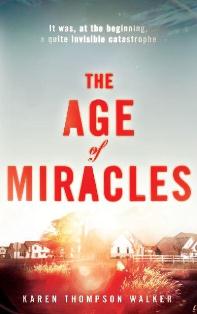
First published back in June of 2012, ‘The Age Of Miracles’ formed the debut release for US author Karen Thompson Walker.
DLS Synopsis:
Julia is an eleven-year-old girl living with her mother and father in California. She’s young and living a quiet life, with just one girl, Hannah, someone who she is able to call a friend. But this is okay. Julia enjoys her life. School isn’t too troublesome for her, other than the awkwardness that takes place whilst waiting with the other students for the school bus each morning. Besides, she still has Seth Moreno to daydream over.
However, everything changes on the day when it’s first discovered that the world’s constant rotation has slowed down ever so slightly. No longer is a day a ridged twenty-four hours. With the ‘slowing’ (as it has quickly been dubbed), so the days begin to extend, the time between light and dark, and dark and light now growing longer. Moreover, as each day passes the slowing is continuing. Days carry on stretching out longer and longer. And the inhabitants of earth are becoming very nervous.
However, life continues, and all around Julia people try to carry on with their lives the best they can. Julia keeps attending school, her father continues to go to work, and her mother continues to worry. But it can’t go on forever like that. Soon enough the days have become so long, with the nights in turn lingering on, that the government brings back the concept of ‘clock-time’. Although the days and nights will quickly become out of sync with the elongating hours of light and darkness, ‘clock-time’ maintains a more constant lifestyle. Companies can begin to function properly again. Schools can run on schedules. And lives can get back into a more routine form of existence.
But some choose not to adopt ‘clock-time’. Instead, they decide to live their lives in what they call ‘real-time’. And all around Julia and her family, the constant stress of the escalating global epidemic begins to cause more problems and fundamentally alter more lives. People begin to suffer from what is being referred to as the ‘syndrome’. An unexplainable sickness that is somehow related to the slowing of the earth’s rotation. Crops begin to die off with the lack of sunlight during the long dark nights. Birds begin to die off en masse. The tides become more pronounced, swallowing up coastal homes. And the sea life gradually starts to die off.
Gradually, day by day, as the constant slowing continues to affect the world’s inhabitants, life on the planet slowly begins to fall apart…
DLS Review:
Walker’s quietly paced exploration into a somewhat original apocalyptic scenario is certainly an interesting one. Written in the past tense through the eyes of the young girl, Julia, the catastrophic events unfolding upon around everyone take place within a mild coming-of-age storyline, whereby Julia is taking her first hesitant steps into the very beginnings of womanhood.
In a similar way to David Moody’s highly emotional apocalyptic romance ‘Straight To You’ (1996), Walker’s tale is more about the life of one particular person than becoming altogether swallowed up with the monumentally dramatic events of this slowly creeping Armageddon.
It’s certainly true that, aside from the unavoidable doom of the ‘slowing’, not a great deal of any considerable drama actually happens in the tale. There’s the run-of-the-mill first-romance with Seth Moreno that takes quite some time to get underway, there’s troubling family issues and various other miniature emotional events that keep the plot chugging along at a reasonably consistent rate. But it’s really the well-thought out examination of the unfolding epidemic that keeps the reader’s interest in the tale from start to finish. Barely a page goes by without the inclusion of some intricate examination of how the ‘slowing’ has affected yet another aspect of their lives. How society is adjusting yet again in order to try to adapt to the changing environment around them.
With such a doom-and-gloom concept behind the fundamental plot of the tale, this unavoidable descent into an utterly bleak dystopian future forecasts and eventually delivers a great wealth of sadness across the entire landscape that the book describes. Death and demise in plant, animal and eventually human lives are on the cards from the very first few chapters. And it’s this inevitability, this unavoidable doom, which really gets to the reader in the end.
The real strength of the novel lies with the constantly evolving details. Like within George R Stewat’s classic ‘Earth Abides’ (1949) or indeed John Christopher’s ‘The Death Of Grass’ (1956), the smallest changes in our environment are shown to have such catastrophic repercussions. And as these ‘small changes’ snowball, so the repercussions escalate until we’re on the very brink of extinction.
Alas, where the novel is particularly let down is with the surprisingly weak characterisation. For such a character-driven storyline, the often disappointingly understated emotional turmoil that should obviously be occurring, the poorly explored conflicting character responses to the dilemma and the development of stress towards the inevitable doom is sadly lacking in any real substance. This is a hell of a shame. Had Walker succeeded in portraying a scenario more in-tune with human emotions, then ‘The Age Of Miracles’ could have been so much more.
The ending to the tale does (rather intentionally) peter out rather than explode in a dramatic finale. This is however done in a highly emotive fashion, once again drawing somewhat similar comparisons to David Moody’s ‘Straight To You’ (1996). But it works…and once the final page has been read, it’s hard not to feel at the very least ever-so-slightly moved by the gradual fall of our world.
The novel runs for a total of 269 pages.

© DLS Reviews






